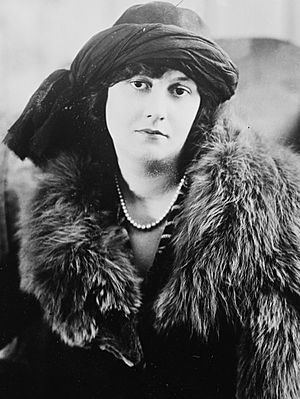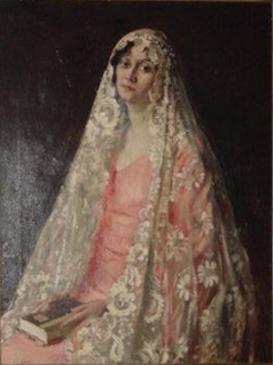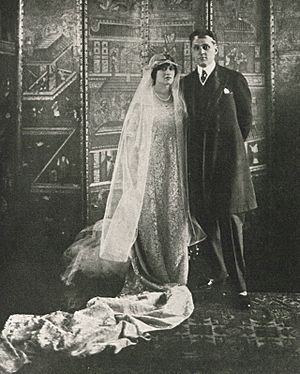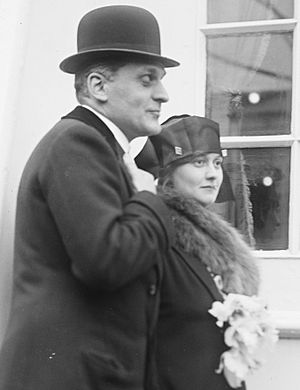Elizabeth Bibesco facts for kids
Quick facts for kids
Elizabeth Bibesco
|
|
|---|---|

Elizabeth Asquith Bibesco, circa 1919
|
|
| Born |
Elizabeth Charlotte Lucy Asquith
26 February 1897 |
| Died | 7 April 1945 (aged 48) |
| Resting place | Mogoșoaia, Romania |
| Nationality | British |
| Other names | Elizabeth Asquith Elizabeth Bibesco |
| Occupation | Actress, writer, novelist |
| Years active | 1921–1940 |
| Spouse(s) | Antoine Bibesco (1919–1945) |
| Children | 1 |
| Parents |
|
Elizabeth, Princess Bibesco (born Elizabeth Charlotte Lucy Asquith; 26 February 1897 – 7 April 1945) was a British socialite, actress, and writer. She was active between 1921 and 1940. Elizabeth was the daughter of H. H. Asquith, who was the British Prime Minister. Her mother was the writer Margot Asquith. Elizabeth married Antoine Bibesco, a Romanian prince and diplomat. Her writings often used her experiences from growing up in British high society. A book of her stories, poems, and clever sayings, called Haven, was published after she died in 1951.
Contents
Growing Up: A Prime Minister's Daughter
Elizabeth Charlotte Lucy Asquith was the first child of H. H. Asquith and his second wife, Margot Tennant. Her father was the British Prime Minister from 1908 to 1916. Her mother wrote in her autobiography that Elizabeth was a very smart child. She was also known for having a strong personality.
Being the Prime Minister's daughter meant she was famous from a young age. She became very clever and good at talking to people, even adults. When she was 12, she asked the famous writer George Bernard Shaw to write a play for her. She wanted to put on the play to raise money for charity. He wrote The Fascinating Foundling, which Elizabeth directed with other children as actors.
When she was only 14, a newspaper called The Times wrote about her. They said many members of Parliament knew her and liked her charm. They also noted her early interest in politics. As a teenager during World War I, she helped with "good works." She organized and performed in afternoon shows for soldiers. Her first known writing was a short play for two people called "Off and On." She performed it in 1916. That same year, she organized a big art show to help a charity. She also helped with a poetry reading event. In 1918, she acted in small roles in two silent war movies by D.W. Griffith. These movies were Hearts of the World and The Great Love.
Marriage and Life Abroad
On April 29, 1919, Elizabeth married Prince Antoine Bibesco. He was a member of the House of Bibescu and a Romanian diplomat. He was 22 years older than her. Their wedding was held in London and was a very important event that year. Many famous people attended, from Queen Mary to George Bernard Shaw. The wedding was even filmed by a news company.
After they married, Prince and Princess Bibesco lived in Paris, France. Their home was a beautiful townhouse with large paintings on the walls. A friend described the paintings as "gardens into which you walked."
Antoine Bibesco was a close friend of the writer Marcel Proust. After Elizabeth married Antoine, she also became a favorite of Proust. Proust was a writer who preferred to stay home. He wrote that Elizabeth was "probably unsurpassed in intelligence." He also said she "looked like a lovely figure in an Italian fresco." Proust would often visit them late at night. He would discuss Shakespeare with Elizabeth or chat with Antoine until morning. Elizabeth wrote a touching article about Proust after he died in 1922.
Elizabeth also traveled with her husband for his job as a diplomat. They lived in Washington, D.C. (1920–1926) and then in Madrid, Spain (1927–1931). Their only child, Priscilla Helen Alexandra Bibesco, was born in London in 1920. Priscilla later passed away in Paris in 2004.
Her Books and Stories
Between 1921 and 1940, Elizabeth Bibesco published many works. She wrote three collections of short stories, four novels, two plays, and a book of poetry. Critics in both America and England reviewed her short story collections. Her novel The Fir and the Palm was even published in parts in The Washington Post newspaper.
A writer named Katharine Angell reviewed Elizabeth's book Balloons in 1923. She wrote that Elizabeth was very good at telling a lot in just a few words. She could describe a whole situation in a few phrases. She could even show a lifetime of hopes and failures in just a few pages.
Elizabeth's last novel, The Romantic, came out in 1940. She dedicated it to Jose Antonio Primo de Rivera, whom she knew in Madrid. Elizabeth Bowen wrote an introduction to Haven, a book of Elizabeth's works published after she died. Bowen said that Elizabeth's characters lived in a special world. In this world, people didn't always follow the usual rules about what to feel or say.
Later Life and Legacy
Elizabeth was in Romania during World War II. She sadly died there from pneumonia in 1945, at the age of 48. She was buried in her husband's family graveyard. This graveyard is on the grounds of Mogoșoaia Palace near Bucharest. Her tombstone has a line from one of her poems: "My soul has gained the freedom of the night." Her death was a great sadness for her mother, Margot, who died just a few months later. Prince Antoine had to leave Romania after the war. He never returned to his home country and died in Paris in 1951. Their daughter, Priscilla Hodgson, continued to live in their Paris home until she died in 2004.
Famous Portraits

The artist Augustus John painted Elizabeth's portrait two times. The first painting was in 1919. It shows her as a lively young woman with a feather scarf. This painting is in the Laing Art Gallery in Newcastle upon Tyne, England. The second painting was done five years later. In this portrait, Elizabeth looks a bit thoughtful or sad. Her eyes are turned away, suggesting she might not be as confident as before. She is wearing a lace veil called a mantilla, which her father received from the Queen of Portugal. She is also holding one of her own books. When this painting was shown in 1924, a writer said it made all other pictures in the room look dull. This was because of the strong contrast between her dark eyes and hair and the bright white lace.
Selected Works
- I Have Only Myself to Blame, 1921 – short stories
- Balloons, 1922 – short stories
- The Painted Swan, 1922 – play
- The Fir and the Palm, 1924 – novel
- The Whole Story, 1925 – short stories
- There is No Return, 1927 – novel
- Points of View, 1927 – play
- Poems, 1927 – poetry
- Portrait of Caroline, 1931 – novel
- The Romantic, 1940 – novel



